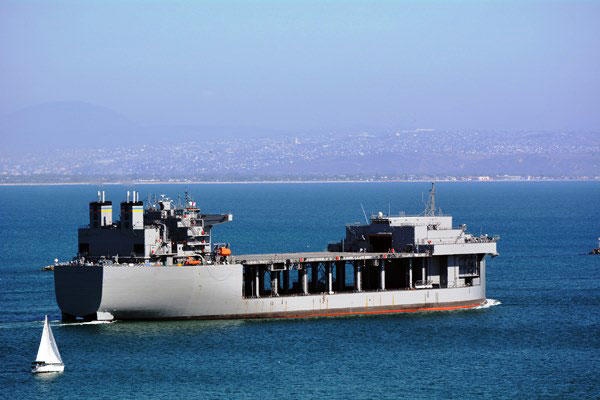Global demand is high for new sea-basing platforms that can take some of the operational pressure off of amphibious ships, the Marine general in charge of the Navy's Expeditionary Warfare Division said Tuesday.
Speaking to an audience at the Surface Navy Association symposium near Washington, D.C., Maj. Gen. Christopher Owens said the expeditionary sea base and expeditionary transfer dock, both variants on a modified civilian oil tanker design, were expected to take on humanitarian-assistance and disaster-relief missions, as well as embassy security reinforcement and noncombatant evacuation missions in an uncontested environment.
Unlike the expeditionary transfer dock, the so-called ESB is equipped with a flight deck with room for two CH-53 helicopters. With limited berthing space for Marine units, the platform may be an attractive stopgap to support the overworked amphibs.
"I emphasized they're not warships," Owens said. "They don't have the guns. They don't have the defense capabilities. They don't have the trained Navy crews ready to fight in the ship and keep it alive but they can provide great capability for lower-end crisis response and to allow [geographic combatant commanders] to employ those scarce [amphibious] assets."
These mission sets represent a significant portion of the tasks that might be assigned to a traditional amphibious ship, and would come in addition to the sea-basing vessels' primary mission of supporting prepositioning forces at sea.
The first ESB, formerly known as an afloat forward staging base, is the USNS Lewis B. Puller. That ship was delivered to the Navy in June and is completing testing and evaluation in Norfolk, Virginia, ahead of a deployment as soon as this year to replace the amphibious transport dock Ponce in the Persian Gulf. The platform may receive upgrades to accommodate special operations forces ahead of its deployment, according to reports from USNI News.
Owens said a destination had yet to be chosen for the next two ESBs, which have yet to be named. General Dynamics Corp.'s NASSCO unit began construction on ESB-4 in October, and a contract for ESB-5 may be awarded within fiscal 2017.
"There's already a lot of demand for ESB 4 and 5," Owens said. "It will remain for the [geographic combatant commanders] to state their case but we do expect demand to continue as the ships prove their utility."
--Hope Hodge Seck can be reached at hope.seck@monster.com.




























